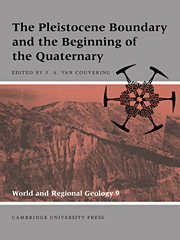Book contents
- Frontmatter
- Contents
- List of contributors
- Preface: the new Pleistocene
- Foreword
- Part I Definition of the base of the Quaternary
- Part II Characterization of the Pleistocene boundary-stratotype
- Part III The paleontological context of the Pleistocene boundary
- Part IV The Pleistocene boundary in regional sequences
- 11 The Pliocene–Pleistocene boundary in Italy
- 12 Stratigraphy of the Plio–Pleistocene sequence of the Mediterranean coastal belt of Israel and its implications for the evolution of the Nile Cone
- 13 The Pliocene–Pleistocene transition in the Iberian Peninsula
- 14 Biostratigraphy and calibrated climatic chronology of the Upper Pliocene and Lower Pleistocene of France
- 15 The Plio–Pleistocene of England and Iceland
- 16 The Neogene–Ouaternary boundary in The Netherlands
- 17 The Tertiary–Quaternary boundary in western Germany
- 18 The Pliocene–Pleistocene boundary in eastern Germany
- 19 The Plio–Pleistocene of Hungary
- 20 The Pliocene–Pleistocene boundary in Romania
- 21 The Pliocene and Pleistocene of the European part of the Commonwealth of Independent States
- 22 The N/Q boundary in Asian Russia and Tadjikistan
- 23 The Pliocene–Pleistocene boundary in the Indian subcontinent
- 24 The Pliocene–Pleistocene boundary in Japan: the Osaka Group, Kinki district
- 25 The Pliocene–Pleistocene boundary in Japan: stratigraphy in the Boso Peninsula, central Japan
- 26 The base of the Quaternary in China
- 27 Plio–Pleistocene deposits and the Quaternary boundary in sub-Saharan Africa
- 28 Plio–Pleistocene reference sections in Indonesia
- 29 The Pliocene–Pleistocene boundary in New Zealand
- 30 The Pliocene–Pleistocene boundary in continental sequences of North America
- Index
30 - The Pliocene–Pleistocene boundary in continental sequences of North America
Published online by Cambridge University Press: 10 November 2009
- Frontmatter
- Contents
- List of contributors
- Preface: the new Pleistocene
- Foreword
- Part I Definition of the base of the Quaternary
- Part II Characterization of the Pleistocene boundary-stratotype
- Part III The paleontological context of the Pleistocene boundary
- Part IV The Pleistocene boundary in regional sequences
- 11 The Pliocene–Pleistocene boundary in Italy
- 12 Stratigraphy of the Plio–Pleistocene sequence of the Mediterranean coastal belt of Israel and its implications for the evolution of the Nile Cone
- 13 The Pliocene–Pleistocene transition in the Iberian Peninsula
- 14 Biostratigraphy and calibrated climatic chronology of the Upper Pliocene and Lower Pleistocene of France
- 15 The Plio–Pleistocene of England and Iceland
- 16 The Neogene–Ouaternary boundary in The Netherlands
- 17 The Tertiary–Quaternary boundary in western Germany
- 18 The Pliocene–Pleistocene boundary in eastern Germany
- 19 The Plio–Pleistocene of Hungary
- 20 The Pliocene–Pleistocene boundary in Romania
- 21 The Pliocene and Pleistocene of the European part of the Commonwealth of Independent States
- 22 The N/Q boundary in Asian Russia and Tadjikistan
- 23 The Pliocene–Pleistocene boundary in the Indian subcontinent
- 24 The Pliocene–Pleistocene boundary in Japan: the Osaka Group, Kinki district
- 25 The Pliocene–Pleistocene boundary in Japan: stratigraphy in the Boso Peninsula, central Japan
- 26 The base of the Quaternary in China
- 27 Plio–Pleistocene deposits and the Quaternary boundary in sub-Saharan Africa
- 28 Plio–Pleistocene reference sections in Indonesia
- 29 The Pliocene–Pleistocene boundary in New Zealand
- 30 The Pliocene–Pleistocene boundary in continental sequences of North America
- Index
Summary
Introduction
Stratigraphic sections coeval with the Pliocene–Pleistocene boundary section at Vrica have been securely identified in two long terrestrial sequences in the southwestern USA: the San Pedro Valley sequence in Arizona and the Anza-Borrego Badlands sequence in southern California. Those sequences, with excellent chronologic resolution afforded by magnetostratigraphy, biostratigraphy, and isotope dating, provide a framework for interpreting the evolutionary and paleoclimatic changes in North America at the Pliocene–Pleistocene boundary, as well as for interpreting the sequence and effects of intercontinental dispersal events in the late Cenozoic.
Glacial climate change and continental Plio–Pleistocene correlations
In the late 1930s, the so-called Wood Committee (Wood et al., 1941) assigned the Blancan Provincial Land Mammal Age to the late Pliocene and inferred that the Pliocene–Pleistocene boundary was located at the end of the Blancan. Although no formal Pleistocene land mammal age was proposed in the 1941 report, a list of Pleistocene mammals was given, for which the term “Rancholabrean” (characterized by the famous remains from the Rancho La Brea tar pits in Los Angeles) later came into general use. In 1951, D. E. Savage identified the Irvington fauna of the San Francisco Bay area as the type for a new “Irvingtonian” land mammal age, for early Pleistocene, post-Blancan and pre-Rancholabrean fossil mammal faunas. Thus, by the early 1950s, three late Cenozoic land mammal ages (Blancan, Irvingtonian, and Rancholabrean) had been identified in the late Cenozoic of North America, and the Pliocene–Pleistocene boundary (in North American vertebrate paleontology) was placed at the Blancan–Irvingtonian boundary.
- Type
- Chapter
- Information
- The Pleistocene Boundary and the Beginning of the Quaternary , pp. 278 - 290Publisher: Cambridge University PressPrint publication year: 1996

